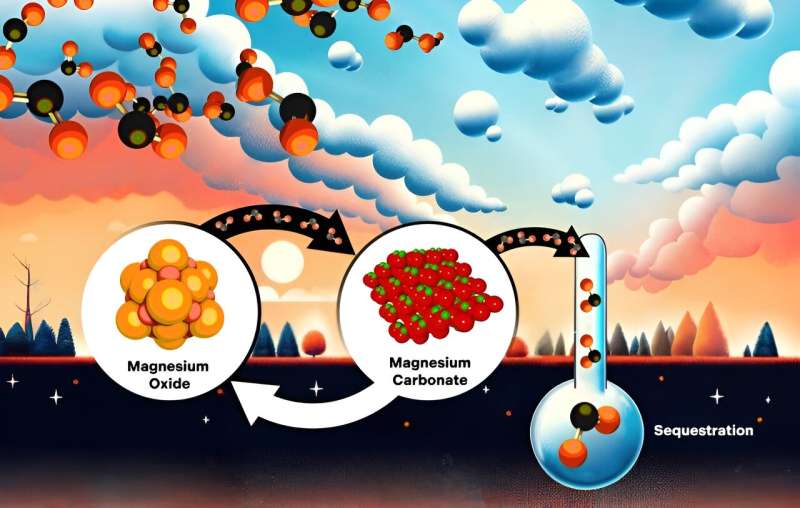This article has been reviewed according to Science X's editorial process and policies. Editors have highlighted the following attributes while ensuring the content's credibility:
fact-checked
peer-reviewed publication
trusted source
proofread
Time-tested magnesium oxide: Unveiling CO₂ absorption dynamics

Magnesium oxide is a promising material for capturing carbon dioxide directly from the atmosphere and injecting it deep underground to limit the effects of climate change. But making the method economical will require discovering the speed at which carbon dioxide is absorbed and how environmental conditions affect the chemical reactions involved.
Scientists at the Department of Energy's Oak Ridge National Laboratory analyzed a set of magnesium oxide crystal samples exposed to the atmosphere for decades, and another for days to months, to gauge the reaction rates. They found that carbon dioxide is taken up more slowly over longer time periods because of a reacted layer that forms on the surface of the magnesium oxide crystals.
The findings are published in the journal Environmental Science & Technology.
"This reacted layer is a complicated mix of different solids, which limits the ability of carbon dioxide molecules to find fresh magnesium oxide to react with. To make this technology economical, we are now looking at ways to overcome this armoring effect," said ORNL's Juliane Weber, the project's principal investigator.
Andrew Stack, a scientist at ORNL and team member on the project, stated, "If we can do so, this process might be able to achieve the Carbon Negative Energy Earthshot goal of capturing gigaton levels of carbon dioxide from air for less than $100 per metric ton of carbon dioxide."
Most of the previous research, aimed at understanding how fast the magnesium oxide and carbon dioxide chemical reactions occur, relied on rough calculations rather than materials testing. The ORNL study marks the first time a multidecade test has been conducted to determine the reaction rate over long time scales. Using transmission electron microscopy at the Center for Nanophase Materials Science, or CNMS, at ORNL, the researchers found that a reacted layer forms. This layer consists of a variety of complex crystalline and amorphous hydrated and carbonate phases.
"Additionally, by performing some reactive transport modeling computer simulations, we determined that as the reacted layer builds up, it gets better and better at blocking carbon dioxide from finding fresh magnesium oxide to react with," ORNL's researcher Vitaliy Starchenko said. "Thus, going forward, we are looking at ways to bypass this process to allow carbon dioxide to find fresh surface with which to react."
The computer simulations help scientists and engineers understand how the reacted layer evolves and changes the way in which substances move through it over time. Computer models enable predictions concerning the reactions and movement of materials in natural and engineered systems, such as materials sciences and geochemistry.
More information: Juliane Weber et al, Armoring of MgO by a Passivation Layer Impedes Direct Air Capture of CO2, Environmental Science & Technology (2023). DOI: 10.1021/acs.est.3c04690
Journal information: Environmental Science & Technology
Provided by Oak Ridge National Laboratory





















